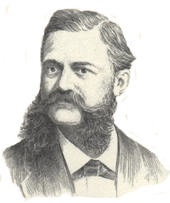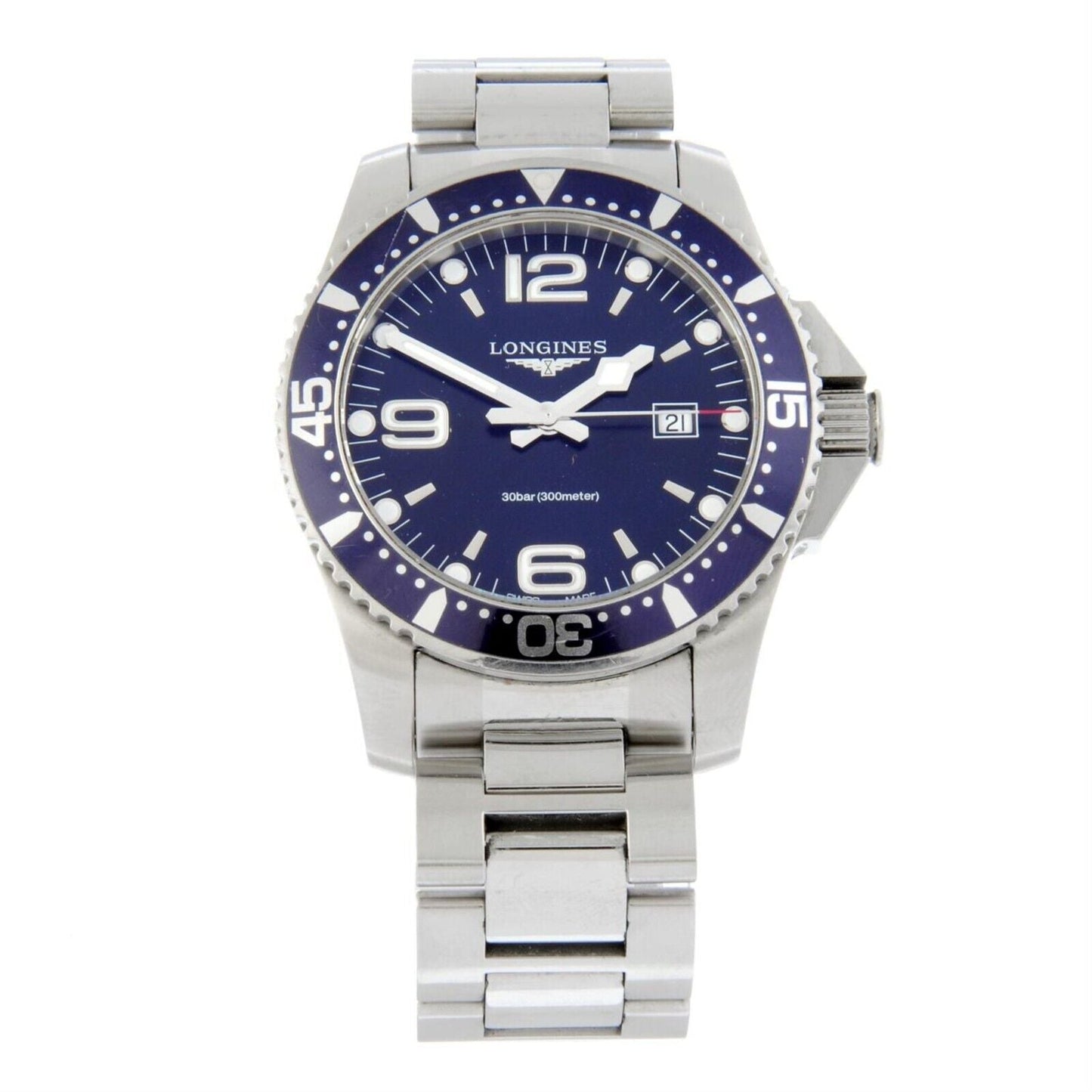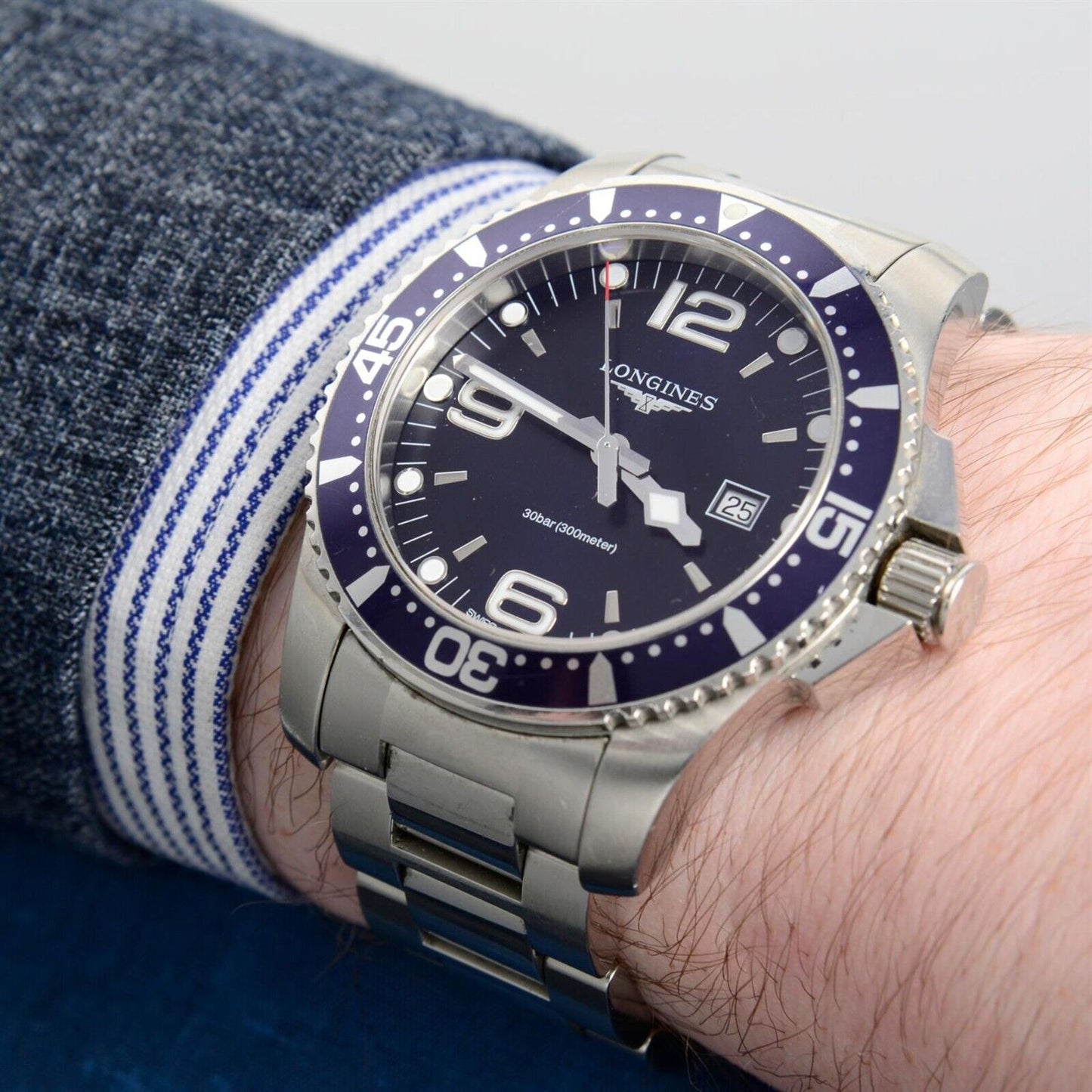Longines
Longines Hydro Conquest L3.840.4 300m Diver's Watch Men's Quartz
Longines Hydro Conquest L3.840.4 300m Diver's Watch Men's Quartz
Couldn't load pickup availability
Longines – a Hydro Conquest wristwatch. Stainless steel case with calibrated bezel. Case width 44 mm. Reference L3.840.4, serial number 45394997. Signed quartz caliber L.157.3 with quick-date setting.
Longines
The Compagnie des Montres Longines, Francillon SA is a traditional Swiss watch manufacturer with the oldest registered watch trademark in the world. The company dates back to a production facility built in 1832 in Saint-Imier , Switzerland, where the company headquarters are still located today. The name is based on an area acquired in 1866. [2] In the company's own museum (opened in 1992) [2], the company's history can be traced through pocket watches and wristwatches, chronographs, timepieces, and navigation instruments. The logo depicts a winged hourglass . Longines produces mechanical watches and quartz watches in the mid- to high-price range. Until 1986, Longines also built its own calibers . [3] [4] The company is now part of the Swatch Group. Approximately 1.5 million watches are produced annually. [4] Company history and milestones of development

In 1832, Auguste Agassiz , brother of the naturalist Louis Agassiz , opened an office for watchmaking and trading ( French "Comptoir d'établissage" , purchasing of raw movements and parts, assembly work by subcontractors, e.g. watchmakers working from home) in Saint-Imier with the watch dealers Henri Raiguel and Florian Morel. [2] [5] [6] Agassiz presented the watches "in the style of Saint-Imier", which soon became known for their particularly durable properties, at trade fairs throughout Europe and quickly gained a good reputation and a high level of recognition. In 1854, his nephew Ernest Francillon took over the management of the company. A prolonged economic crisis around 1860 made it necessary to reduce costs by rationalising watchmaking; Francillon is considered one of the pioneers of industrial production in Swiss watchmaking, [2] with the significant involvement of Jacques David. David studied in 1876, among other things. Triggered by a visit to the World Exhibition in Philadelphia , he also discovered the large-scale production processes at Elgin and Waltham in the United States [2] [6] and became a partner in Longines in 1880. [7] In 1866, Francillon bought a piece of land outside Saint-Imier called Les Longines ("the long meadows") and had a factory built there; one of the location factors was the ability to use hydropower there. The construction of the new factory marked the transition to industrial series production in Longines' history. [5] From 1867 onwards, pocket watches bearing the logo "E. Francillon, Longines, Suisse" were produced. To protect against counterfeiting, the name "Longines" was registered with the Swiss Federal Office for Intellectual Property on May 27, 1889; the hourglass logo was initially used solely to mark movement parts and only appeared on the dial in the 1950s. [8] With the registration with the International Office for Intellectual Property in March 1893, Longines became the oldest registered watch brand in the world. As early as 1873/74, 80 percent of the watches went to the United States of America; [9] the further development of the US market was carried out through distribution partners (from 1880 with Eugene Robert, from 1888 with the A. Wittnauer Company), [10] [11] [12] the business connection with Wittnauer lasted until 1994. 
The first movement with a chronograph function was designated "20H" and dates back to 1878. It was a column-wheel chronograph. The start, stop, and reset functions were controlled by a crown pusher. Three years after Francillon's death, the first mechanical ladies' pendant watches were created in 1903. Two years later, Longines produced the first mechanically manufactured men's wristwatch, which gradually replaced the pocket watch. In the following years, under the leadership of Adrien Francillon, the company focused on timekeeping in sports and supported scientific expeditions. A milestone in the development of pilot's watches was the "Weems second setting watch," based on the ideas of Captain Philip van Horn Weems [16] for navigational assistance. Weems was an instructor at the United States Naval Academy, and Charles Lindbergh was one of his students. Using an adjustable, additional inner dial or a rotating bezel, the watch could be synchronized to the second with a radio-transmitted time signal without affecting the actual running of the watch. Since 1919, the manufacturer from Saint-Imier acted as the official timekeeper for the FAI , [17] and thus Longines was responsible, for example, for the timekeeping of the historic Atlantic crossing by the American aviation pioneer Charles Lindbergh in 1927. Lindbergh subsequently advised the watch manufacturer, based on his experience with the problem of rapid position determination, on the development of a special wristwatch that would enable the determination of longitude during a flight quickly and easily. This watch is also called an hour angle watch [18] because the most important part of determining longitude, the hour angle of Greenwich , can be read directly from the watch. It was available from 1932 under the name "Lindbergh" and can be functionally classified as an extension of the Weems model. Original models from this early period have a solid silver case. [19] Longines manufactured wrist chronographs with a "flyback" function [20] as early as the 1920s, [17] and the mechanism was patented in 1936. [20] In 1929, the airship LZ 127 circumnavigated the world, equipped with onboard chronometers from Longines. [21] In 1945, the first Longines wristwatch with automatic winding was launched, and in 1952 the company was the official timekeeper of the Oslo Winter Olympics. In 1960, a particularly flat electromagnetic movement was developed, in 1967 the "Ultra-Chron" model, a very precise automatic wristwatch with 36,000 vibrations per hour, was launched, and in 1969 a particularly accurate quartz watch called the "Ultra-Quartz" was presented. Longines first introduced watches with LCD displays in 1972, in collaboration with Texas Instruments. [22] The year of manufacture of Longines watches from the period 1870 to 1969 can be determined to within about one year by the production serial number, which is engraved on the back or in the case of spring-loaded watches. [23] Longines built the Wankdorf clock , whose display of the game duration and score of the 1954 FIFA World Cup final (" Miracle of Bern ") became widely known through media coverage. [17] With the advent of quartz watches as mass-produced goods, the company, like many other watch manufacturers, ran into financial difficulties and was integrated into the SMH Group in 1983. Today, the Swatch Group is one of the largest Swiss watch manufacturers, with numerous brands such as Swatch, Breguet , Omega , Blancpain , and Longines. [4] Longines ceased producing its own movements in the 1980s, but since 2009, ETA, as a company of the Swatch Group, has been producing calibers for Longines and according to its specifications for exclusive use, [24] [17] including a column-wheel chronograph with the caliber designation L688. [25] Prominent ownersAlbert Einstein owned a Longines wristwatch and a pocket watch. The wristwatch was auctioned for $ 596,000 in 2008 , and the pocket watch is part of the collection of the Historical Museum in Bern . Humphrey Bogart also wore Longines watches. (also in the film Casablanca ), Amelia Earhart , Audrey Hepburn , Polar explorer Richard Byrd , Howard Hughes or Oskar Schindler , whose watch was sold for over 46,000 US dollars at an auction in March 2019
|
||||||||||||||||||











